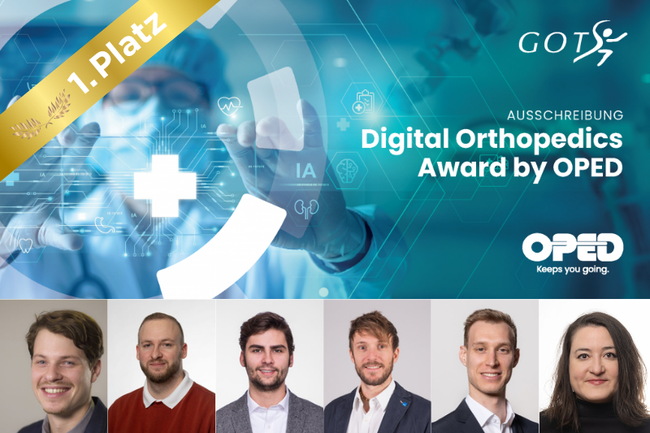1st Place at GOTS Digital Orthopedics Award 2025
Interdisciplinary team from St. Pölten University of Applied Sciences and the Orthopaedic Hospital Speising honored with Digitalization Award
Digital technologies such as artificial intelligence and cloud computing are opening up entirely new possibilities. What was once only possible in specialized biomechanics laboratories can now, at least to some extent, be performed almost anywhere. While the accuracy of such systems currently still falls short of established gait analysis standards, technological progress is advancing rapidly and raises great expectations for future applications.
Against this backdrop, an interdisciplinary research team from the Institute of Health Sciences, the Institute of Creative\Media/Technologies, the Center for Digital Health and Social Innovation (CDHSI), and the Orthopaedic Hospital Vienna Speising was awarded 1st place at the GOTS Digital Orthopedics Award. The prize, presented by the German-speaking Society for Orthopaedic-Traumatologic Sports Medicine (GOTS), recognizes outstanding research in the field of digital medicine and is endowed with €1,000.
Digitalization in Biomechanical Functional Diagnostics
The GOTS is the largest professional society for sports orthopaedics and sports traumatology in the German-speaking region, with more than 1,500 members from Germany, Austria, and Switzerland. Founded in 1986, its mission is to promote the quality of sports medicine care, strengthen scientific exchange, and establish evidence-based standards for the treatment of sports injuries.
With the Digital Orthopedics Award, GOTS honors innovative research contributions in areas such as wearables, AI in medicine, digital motion analysis, tele-rehabilitation, and big data, fields that are becoming increasingly relevant for prevention, rehabilitation, and clinical decision support.
Smartphone-Based Gait Analysis: Validity and Reliability
The award-winning study, entitled “Gait analysis with a smartphone? Validity and reliability of a KI-based monocular markerless 3D gait analysis,” investigated how artificial intelligence applied to simple smartphone videos can support three-dimensional motion analysis.
The results showed that such systems are capable of capturing key movement parameters with moderate accuracy. While their precision still lags behind the marker-based gold standard, the findings highlight the potential of these methods for future low-threshold, mobile, and location-independent gait analysis.
Publication in Journal of Biomechanics
The study results have been published in the international journal Journal of Biomechanics: Horsak B., Simonlehner M., Quehenberger V., Dumphart B., Wegscheider P., Kranzl Andreas (Head of the Gait Laboratory at the Orthopaedic Hospital Speising), Slijepcevic D. (2025). Validity and reliability of monocular 3D markerless gait analysis in simulated pathological gait: A comparative study with OpenCap. Journal of Biomechanics, 193, 112986.
Interdisciplinary Research with a Vision
This recognition highlights how interdisciplinary collaboration between physiotherapy, sports science, digital technologies, and clinical orthopaedics is opening new pathways in digital health research.
Through projects like this, the Center for Digital Health and Social Innovation (CDHSI) at St. Pölten University of Applied Sciences, together with partners such as the Orthopaedic Hospital Speising, provides key impulses for an evidence-based and practice-oriented advancement of digital diagnostics in orthopaedics and rehabilitation.

